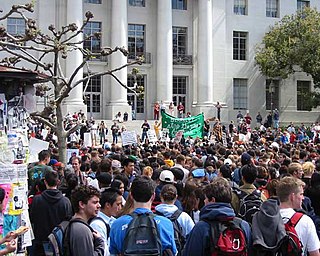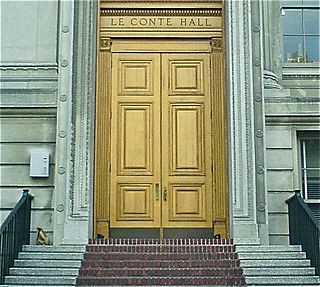
The University of California, Berkeley is a public land-grant research university in Berkeley, California, United States. Founded in 1868 and named after the Anglo-Irish philosopher George Berkeley, it is the state's first land-grant university and is the founding campus of the University of California system.

The Native Sons of the Golden West (NSGW) is a fraternal service organization founded in the U.S. state of California in 1875, dedicated to historic preservation and documentation of the state's historic structures and places, the placement of historic plaques, and other charitable functions in California. In 1890 the organization placed California's first marker honoring the discovery of gold, which gave rise to the state nickname, "The Golden State". U.S. President Richard M. Nixon and Chief Justice Earl Warren served terms as presidents of the NSGW.

Sproul Plaza is one center of student activity at the University of California, Berkeley. It is divided into two sections: Upper Sproul and Lower Sproul. They are vertically separated by twelve feet (3.7 m) and linked by a set of stairs.

Bowles Hall is a coed residential college at the University of California, Berkeley, known for its unique traditions, parties, and camaraderie. Designed by George W. Kelham, the building was the first residence hall on campus, dedicated in 1929, and was California's first state-owned residence hall. It was built in 1928 with a $350,000 grant from Mary McNear Bowles in memory of her husband, Berkeley alumnus and University of California Regent Phillip E. Bowles. Mr. Bowles was said to have three loves: horses, horticulture and the University of California.

The University House is a residence and venue for official events on the campus of the University of California, Berkeley. Designed by the architect Albert Pissis and completed in 1911, it was formerly named President's House while it served as the home of the president of the University of California, starting with Benjamin Ide Wheeler and ending with Robert Gordon Sproul. Since 1965, it has been the home of the Chancellor of the Berkeley campus.

Campbell High School was the first high school to open in the Campbell Union High School District. The school was established on September 14, 1900, in Campbell, California. It is also sometimes called Campbell Union High School, and the abbreviation can be found both as CHS or CUHS.

The Order of the Golden Bear is an honor society at the University of California, Berkeley composed of students, faculty, and alumni committed to serving the University of California.
The campus of the University of California, Berkeley, and its surrounding community are home to a number of notable buildings by early 20th-century campus architect John Galen Howard, his peer Bernard Maybeck, and their colleague Julia Morgan. Subsequent tenures as supervising architect held by George W. Kelham and Arthur Brown, Jr. saw the addition of several buildings in neoclassical and other revival styles, while the building boom after World War II introduced modernist buildings by architects such as Vernon DeMars, Joseph Esherick, John Carl Warnecke, Gardner Dailey, Anshen & Allen, and Skidmore, Owings and Merrill. Recent decades have seen additions including the postmodernist Haas School of Business by Charles Willard Moore, Soda Hall by Edward Larrabee Barnes, and the East Asian Library by Tod Williams Billie Tsien Architects.

Thomas Hall, built in 1905, is a historic building located in Murphree Area on the campus of the University of Florida in Gainesville, Florida, United States. The building is named for William Reuben Thomas, the Gainesville mayor and businessman responsible for bringing the University of Florida to Gainesville.

Gilman Hall is a building on the campus of the University of California, Berkeley. Room 307 was where Glenn T. Seaborg and his coworkers identified plutonium as a new element on February 23, 1941 and as such, is designated a National Historic Landmark. The building itself is designated a National Historic Chemical Landmark, recognizing the two Nobel Prizes in Chemistry that have resulted from research done in the building.

South Hall is the oldest building on the campus of the University of California, Berkeley, built in 1873 in the Napoleon III style. It is the only remaining building of the original campus. South Hall was originally the counterpart of North Hall, which no longer exists, but was located where the Bancroft Library currently stands.
This is an incomplete list of historic properties and districts at United States colleges and universities that are listed on the National Register of Historic Places (NRHP). This includes National Historic Landmarks (NHLs) and other National Register of Historic Places listings. It includes listings at current and former educational institutions.

Sonoma Plaza is the central plaza of Sonoma, California. The plaza, the largest in California, was laid out in 1835 by Mariano Guadalupe Vallejo, founder of Sonoma.

Wasco Union High School (WUHS) is a public American senior high school in Wasco, California. The school is part of the Wasco Union High School District and takes in incoming freshmen from the Wasco Union School District, Maple School District, Lost Hills Union School District, Semitropic School District, St. John's Catholic School, and North Kern Christian School.

This is a list of the National Register of Historic Places listings in Alameda County, California.

George William Kelham (1871–1936) was an American architect, he was most active in the San Francisco Bay Area.
The University of Arkansas Campus Historic District is a historic district that was listed on the National Register of Historic Places on September 23, 2009. The district covers the historic core of the University of Arkansas campus, including 25 buildings.

LeConte Hall is the former name of a building on the campus of the University of California, Berkeley, which is home to the physics department. LeConte Hall was one of the largest physics buildings in the world at the time it was opened in 1924, and was also the site of the first atom collider, built by Ernest O. Lawrence in 1931.

The First Unitarian Church in Berkeley, California is a former church building that was built in 1898. It was designed by Albert C. Schweinfurth, who made unconventional use of Shingle Style architecture, usually applied to homes, in designing a church. It was also highly unusual for a church building in several other ways, including the use of industrial-style metal sash windows, sections of redwood tree trunks as pillars, the strong horizontal emphasis, and a semicircular apse with a conical roof. The building is listed on the National Register of Historic Places, the California State Historic Resources Survey, and is a City of Berkeley Landmark. It has also been known as University Dance Studio and Bancroft Dance Studio for its current use.

Julia Morgan Hall is a historic building in the University of California Botanical Garden in Berkeley, California. Built in 1911, the building was designed by prominent California architect Julia Morgan and originally located on the central campus of the University of California, Berkeley, near the present location of the Haas School of Business. It served as a gathering place for Berkeley's female students, who wanted a female counterpart to Senior Hall, the senior men's meeting hall.






















